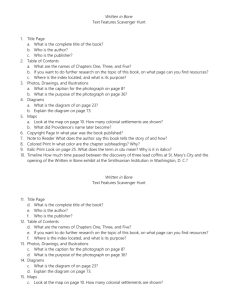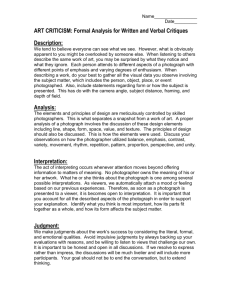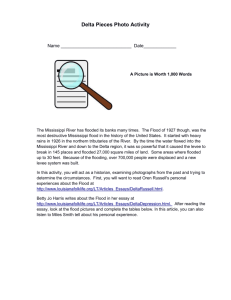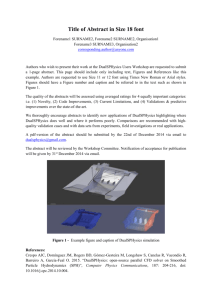Document
advertisement
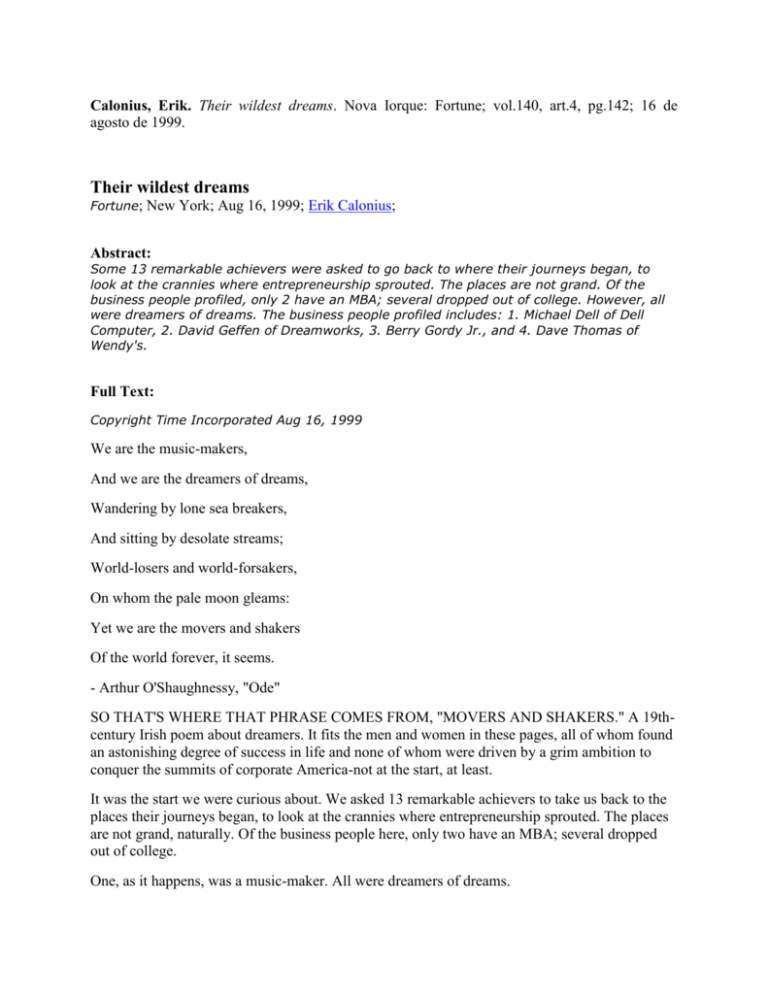
Calonius, Erik. Their wildest dreams. Nova Iorque: Fortune; vol.140, art.4, pg.142; 16 de agosto de 1999. Their wildest dreams Fortune; New York; Aug 16, 1999; Erik Calonius; Abstract: Some 13 remarkable achievers were asked to go back to where their journeys began, to look at the crannies where entrepreneurship sprouted. The places are not grand. Of the business people profiled, only 2 have an MBA; several dropped out of college. However, all were dreamers of dreams. The business people profiled includes: 1. Michael Dell of Dell Computer, 2. David Geffen of Dreamworks, 3. Berry Gordy Jr., and 4. Dave Thomas of Wendy's. Full Text: Copyright Time Incorporated Aug 16, 1999 We are the music-makers, And we are the dreamers of dreams, Wandering by lone sea breakers, And sitting by desolate streams; World-losers and world-forsakers, On whom the pale moon gleams: Yet we are the movers and shakers Of the world forever, it seems. - Arthur O'Shaughnessy, "Ode" SO THAT'S WHERE THAT PHRASE COMES FROM, "MOVERS AND SHAKERS." A 19thcentury Irish poem about dreamers. It fits the men and women in these pages, all of whom found an astonishing degree of success in life and none of whom were driven by a grim ambition to conquer the summits of corporate America-not at the start, at least. It was the start we were curious about. We asked 13 remarkable achievers to take us back to the places their journeys began, to look at the crannies where entrepreneurship sprouted. The places are not grand, naturally. Of the business people here, only two have an MBA; several dropped out of college. One, as it happens, was a music-maker. All were dreamers of dreams. IN HIS FIRST college apartment, Michael Dell found one day that his roommate had piled his computer parts against the door, suggesting that he move out. And when Dell's parents popped in one evening, Michael hid his computer supplies in the bathtub. "Where are your textbooks?" his father asked. "Oh, I left them down at the library," young Michael replied. Later that year Dell moved into a room on the 27th floor of Dobie Hall at the University of Texas and tried to act more like a typical college freshman. But it didn't work. He placed classified ads offering computer upgrades and soupedup IBM PCs at 15% off retail prices. "People would ride up to the 27th floor with their computers. I'd put in some memory or a disk drive, they'd pay me, and I'd send them on their way," Dell recalls. The UPS delivery man was a frequent visitor too. "He was always a bit out of sorts because he had to unload the stuff on the back dock and haul it all the way up here," says Dell. [Photograph] Caption: Room 2713, Dobie Hall, University of Texas Michael Dell Dell's hallmates didn't seem to mind, however. Michael had discovered Austin's network-TV feed on the roof of the dorm and had customized it so that everyone on the 27th floor had free cable TV Before long, Dell was grossing about $25,000 a month. He had promised his father that he would take his premed studies seriously, but the computer business was not taking a back seat anymore. By January, Dell had vacated Dobie for a condo near campus. He finished his freshman year, but not before incorporating Dell Computer. "Leaving here really marked the beginning of what became the business," Dell says, looking around the dorm room with a bemused smile. "It was the determination that I wanted to start this business as a real business. I had come to the conclusion that the only way to do it was just to do it. My parents would have to figure it out later." BETWEEN HIGH SCHOOL and the time he landed a job as an usher at the CBS-TV studios in New York City, David Geffen says, he had about 17 jobs. "They were just jobs," he says. "I had to pay the rent:' But when he finally got a job at CBS, "I thought, Oh, God, I love this," Geffen says. "I got to watch them rehearse TV shows with people like Judy Garland and Red Skelton, and I was thinking, Well, I'm not talented, what can I do?'" He got a job on a new CBS TV series, The Reporters-as the receptionist. After studying the scripts one day, Geffen made some suggestions to the producer. "He fired me on the spot," Geffen recalls. The show's casting director offered a sympathetic ear. "I told her I really loved the entertainment business, and was there anything I could do? She said, `Well, what can you do?' And I said, 'Nothing. I don't know how to do anything.' She considered that for a moment and said, 'You don't know how to do anything. Hmmm. You could be an agent." Missing the joke, Geffen grabbed the Yellow Pages and picked out the agency with the biggest ad-and that's how he ended up at the mailroom of the William Morris Agency. "In delivering the mail, you get into everyone's office and you hear them talking on the phone," Geffen says. "It was the first time in my life that I had the epiphany'I can do this!'" Moving up from the mailroom, he plunged into the still-emerging world of rock & roll, signing and managing artists from Laura Nyro to the Eagles. In 1970 he started Asylum Records, and later, after a turbulent year at Warner Bros. Pictures, he got back on track with Geffen Records. Eventually he sold Geffen for $700 million and went on to cofound the DreamWorks movie studio with Steven Spielberg and Jeffrey Katzenberg. IF YOU'D EXITED THE INTERstate at Brookhaven, Miss., in 1979, you'd have found a tall young man named Bernie Ebbers bent into a small office above an antique shop on Denton Trail. "I was in the motel business back then," Ebbers says. "When I got involved in the phone business in 1985, we moved that business upstairs too." How many employees did Ebbers have? He thinks for a moment. "Mmm ... five," he says. [Photograph] Caption: William Morris Agency, Beverly Hills David Geffen [Photograph] Caption: William Morris Agency, Beverly Hills David Geffen Today Ebbers' MCI WorldCom is the fourth-largest telecommunications company in the world, with 70,000 employees and revenues of $32 billion. Raised in Edmonton, Alberta, Ebbers moved to Mississippi after high school. He graduated from Mississippi College with a certificate to teach gym and science. But after a year in the classroom, he realized that a teacher's salary was too meager for the family he hoped to raise someday. "I wasn't anything like an accountant or an engineer," he says. "So I bought a small motel in a small town about 60 miles from here." He bought more motels, and then, Ebbers says, "one day a friend came by and asked me if I'd like to make a small investment in this new thing called telecommunications." Ebbers, two colleagues in the motel business, and the owner of the antique shop started LDDS, a reseller of long-distance service. "There was a board meeting at the Western Sizzler in Hattiesburg, and none of the guys could think of a name. So the waitress came over and said, `Why don't you call it Long Distance Discount Service?' "Ebbers recalls. Ebbers became president of LDDS in 1985 and soon led the company through a series of multibillion-dollar acquisitions, topped by the $37 billion MCI merger, which is one of the biggest in business history. "THERE ARE A LOT OF GHOSTS floating around this place," says Intel CEO Andy Grove, peering into the gutted factory building where Intel began 31 years ago. "What went on here is something I cherish. But the lesson I learned was, never get involved in another startup. One was enough for me." [Photograph] Caption: 611 Denton Trail, Brookhaven, Miss. Bernie Ebbers [Photograph] Caption: [Photograph] Caption: 365 Middlefield Road, Mountain View, Calif. Andy Grove & Gordon Moore It was 1968. Gordon Moore and Robert Noyce, two of the founding partners of Fairchild Semiconductor, decided to strike out on their own. They were soon joined by Grove. Union Carbide Electronics was moving out of a factory in Mountain View, Calif., and Intel moved in, hiring its first employees and building its first memory chips. The startup was financed by famed moneyman Art Rock but was still a shoestring operation: The business plan ran three paragraphs, the chip assemblers wore cotton smocks, and the chips were made using bottled water lugged into the plant by Intel's first engineers. "Andy and I have completely different views of the early years," says Moore. "To me, it was smooth. We grew faster than I thought. But Andy thought it was one of the most traumatic periods of his life." Grove concurs. "In a startup you hire a bunch of strangers, you stick them together, and then you try to do some really heavy lifting. But under the strain there's a lot of infighting," he says. "There was a lot of infighting here. One of the people who reported to me had a nervous breakdown, right in front of my eyes." One of Intel's first successful products was a 1024-bit dynamic RAM memory chip. "It strained the technology, strained the design, and strained our testing abilities," says Grove. Adds Moore: "The code name was 1103, and to this day I still get a twinge when I look down at my digital watch and it says 11:03." Then when did Intel stop feeling like a startup? "It hasn't yet," says Grove with a laugh. BRUCE BENT AND HENRY Brown invented the money market fund 30 years ago. The two started their own investmentbanking firm in 1968, but by 1969 interest rates had climbed to 8%, the highest rate since the Civil War. "Everything came to a screeching halt," says Bent. "Nobody wanted to borrow money." [Photograph] Caption: Corner of 52nd Street and Sixth Avenue, New York Bruce Bent & Henry Brown Brown and Bent needed to attract depositors, but federal banking laws limited interest to 5.25%, and higher-paying CDs were available only to fat cats who could purchase them in lumps of $100,000 each. "I was sitting at my desk in August 1969, and I looked up at Brown and said, `Why not a mutual fund?' "recalls Bent. "He said he didn't know anything about mutual funds. I said, 'I don't know anything about mutual funds either, but I think it would work.' " The idea was to buy the big $100,000 CDs and split the higher interest among small investors. "Everyone said it was impossible to pull off," says Bent. "We said we wanted to have same-day redemptions. They said, 'You can't do that.' We said we wanted daily dividends. They said, `You can't do that.' We said we wanted telephone redemptions. They said, 'You can't do that: " But Bent didn't believe them. He began reading the regs carefully. Nothing said it couldn't be done. When Brown and Bent sent brochures to 144 financial institutions, they were turned down cold. They slipped $250,000 into debt. "We developed an intimate relationship with the hot-dog man on the corner," Bent says, "because that's all we could live on. Hot dogs." At the very last moment, the New York Times came to the rescue with an article lavishly describing Brown and Bent's mutual fund invention. The story broke Jan. 7, 1970, and by February the two had received $1 million in deposits. By the end of 1973 they had their first $100 million, and by 1974, $500 million in depositors' funds. The Reserve fund became America's first money market fund, and Brown and Bent became the Orville and Wilbur Wright of one of the most significant financial innovations of the century. "IMAGINE A WORLD WITHOUT the Supremes, Smokey Robinson, Marvin Gaye, Stevie Wonder, Diana Ross, Michael Jackson, Lionel Richie, the Temptations, and the Four Tops," someone once said, "and you've just imagined a world without Berry Gordy" [Photograph] Caption: [Photograph] Caption: 2648 West Grand Boulevard, Detroit Berry Gordy Jr. Gordy, who worked on the Ford assembly line and sold cookware door to door, submitted in the end to his passion for songwriting and transforming no-names into stars. As a songwriter, Gordy found early success with hits like "Lonely Teardrops," sung by Jackie Wilson. But Gordy soon realized he wanted more control. "To protect my songs, which are my loves, I had to find singers who could sing and record them like I heard them in my head." At 29, with an $800 loan from his family, Gordy founded Motown. He leased a two-story house at 2648 West Grand Boulevard in Detroit. "Everything was makeshift," he says. "We used the bathroom as an echo chamber" Gordy borrowed from his assembly-line experience in refining Motown acts. The kids learned harmony from the vocal coach, steps from the choreography coach, and manners from the etiquette coach. Meanwhile, Motown's songwriters pounded out new tunes. When it was time to perform, the kids-Diana, Marvin, Stevie, Smokey, and the rest-piled into the Motown Revue bus and headed out on the road, competing to see who could win the most applause. By 1975, Motown had become the biggest black-owned business in America, with activities spanning several record labels, film, and television. "I had no idea that Diana Ross would become an industry or that Michael Jackson would become an industry or that the Temptations would become an industry," Gordy says. "While I say I'm a songwriter and businessman, really, deep down, I think I'm a teacher, like my father" AS THE CULTURAL revolution began to sweep America in the early 1960s, Barnes & Noble Chairman Len Riggio was taking night courses at New York University. Hiding behind taller students, he stealthily read the classics during business management classes. Riggio was a book fanatic. During the day he worked at the NYU bookstore. But after six years as a clerk and manager, Riggio succumbed to the entrepreneurial itch. He raised $5,000 in capital (60% borrowed), left school, and with a partner started the Student Book Exchange (SBX) in a nearby storefront. "This was a time of the antiwar movement, the civil rights movement, sexual liberation, changing music," says Riggio. "No one wanted to be told, 'You have to shop at the university books#ore: " Soon SBX was selling more than textbooks-printing posters and leaflets and stocking a new wave of paperback books. "There was an urgency about books-a passion to go out and find the books that people wanted," Riggio says. SBX succeeded, and Riggio soon opened stores at other campuses. "It was never a matter of making a lot of money back then. It never occurred to me that I was building a chain," he says. in 1971, Riggio bought Barnes & Noble and its flagship bookstore on Manhattan's 18th Street-a limping giant that was losing money. "Barnes & Noble was elitist," says Riggio. "We democratized it." Today, of course, the entire book business is being democratized by the Internet; for now, at least, Barnes & Noble is the establishment, and Amazon.com is the revolutionary. "I see the Web as greater than the wheel, the internal combustion engine, or nuclear fission," Riggio exclaims. "I've lived in exciting times over the last 30 years, but this curve is much steeper than anything before." "THERE'S A FALSE STORY THAT I went around measuring pockets. That's not true," says Jeff Hawkins, inventor of the Palm Pilot. But Hawkins did retreat to the proverbial garage to shape a Palm Pilot prototype on his table saw. "I'd take it to meetings," he says, "and pretend I was looking at the calendar." The Palm Pilot, of course, has become one of the fastest-selling high-tech devices of the decade, a product that has generated perhaps the highest level of consumer loyalty and downright affection since the introduction of the Apple Macintosh some 20 years ago. [Photograph] Caption: 17 Waverly Place, New York Len Riggio [Photograph] Caption: Fresh from Cornell with a degree in electrical engineering, Hawkins first worked for Intel and then for GRiD Systems, designing laptops. But his passion was for what he calls "brain stuff!-the study of how brains work and how machines might mimic them more faithfully. Taking an extended leave from GRiD, he developed a breakthrough methodology that would allow computers to recognize patterns and, hence, handwriting. Returning to GRiD, Hawkins applied some of these ideas to the GRiDPad, a reasonably successful pen-based computer. "About this time I had an epiphany,' Hawkins says. "Someday, everybody is going to own something like this. But it's got to be a lot smaller and sell for under $300." [Photograph] Caption: Garage workshop, Redwood City, Calif. Donna Dubinsky & Jeff Hawkins To chase that dream, he started Palm Computing in 1992. The whole hand-held computer market seemed doomed after Apple introduced its now-infamous Newton, but Hawkins kept going with the help of Donna Dubinsky, a Harvard MBA with a great Silicon Valley track record. Hawkins insisted that the computer be small enough to slip into a pocket. They worked out the technical issues, then turned to the financial ones. After being rejected repeatedly (by investors who are now kicking themselves, they found an angel in U.S. Robotics, which not only agreed to fund the Palm Pilot but offered to buy the whole company. Hawkins and Dubinsky have started Handspring Inc., which will create new products under a Palm Pilot license. But Hawkins says he's still stuck on "brain stuff." "I've figured out what it means for an organism to understand its environment," says Hawkins with a shiny-eyed look. "And I think we'll be able to start building machines that will begin to do that:' SOME PEOPLE MIGHT HAVE been angry had they grown up like Wendy's senior chairman, Dave Thomas. He was given up for adoption at six weeks-and his adoptive mother died when he was 5. "When I saw my mother's casket lowered into the ground," he recalls, "it bothered me a lot." His adoptive father was distant and cold, and there was only one place where Dave felt even the distant warmth of family lifewhen he and his father sat near other families at restaurants. By 11, Thomas was out looking for part-time jobs in restaurants. He eventually happened upon the Regas Restaurant in downtown Knoxville, Tenn. It was run by Frank and George Regas, Greek immigrants. "You'd walk in, work as hard as you could, and by the time you took a deep breath, 12 hours was over," Thomas recalls. "I loved it." The Regas treated him like family, but Dave wasn't able to stay long; he and his father moved on to Fort Wayne, where Dave landed a job at the Hobby House restaurant. The Hobby House's owners and staff became his new family, and at 15, Dave finally parted with his father. One day an odd fellow with a black string tie and trimmed goatee walked in, ordered some ribs, and began telling Dave about the secret recipe he had in the back seat of his white Cadillac. It was Colonel Sanders. Before long, Thomas and his partners at the Hobby House were in the Kentucky Fried Chicken business. By age 35, Dave was a millionaire. He founded his own chain, Wendy's (named after his third daughter), which now has 5,452 restaurants. Thomas has a wife, six children, and 15 grandchildren. He has started the Dave Thomas Foundation for Adoption, which urges corporations and the government to get kids out of foster homes quickly. HE CAN'T SPELL, DOESN'T LIKE to read, and admits to no aptitude for high technology. He named his company after the most conspicuous quality of his hair: Kinko's. [Photograph] Caption: Regas Restaurant, 318 Gay Street NW, Knoxville Dave Thomas [Photograph] Caption: But Paul Orfalea, who founded Kinko's in 1970, has become a player in the communications revolution. Kinko's copier centers provide entrepreneurs with a place to duplicate their ideasanything from business plans to blueprints-and bind them into impressive-looking presentations. Most Kinko's stores are open 24 hours a day, seven days a week, making them the all-night diners for the Information Age. Orfalea began selling notebooks on the campus of the University of California at Santa Barbara in 1970, displaying his wares on the sidewalk. He also had a little store nearby in the back of a former hamburger stand, with a filmprocessing machine, a copier, and some school supplies. "Back then, I didn't know if the business would become a photo store, a stationery store, or a copy center," he says. But Orfalea knew he wanted to have a business. His Lebaneseimmigrant parents and their friends were entrepreneurs. Besides, he suffered from such severe dyslexia that he considered himself unemployable. "My only aptitude was for my own business," he says. When Kinko's started, seven million Americans worked out of their homes. But then came downsizing, and that soon rose to more than 40 million. Kinko's became not only the place to burnish one's resume, but an oasis for entrepreneurs. Kinko's stores make a mindboggling 16 billion paper copies a year. The company is also positioned in cyberspace, with computers and software, high-speed ISDN connections, and videoconferencing in 140 stores. If a young Henry Ford, Scott Joplin, or Frank Lloyd Wright were alive today, chances are you'd bump into him at a Kinko's. [Photograph] Caption: University of California, Santa Barbara Paul Orfalea Reproduced with permission of the copyright owner. Further reproduction or distribution is prohibited without permission.


